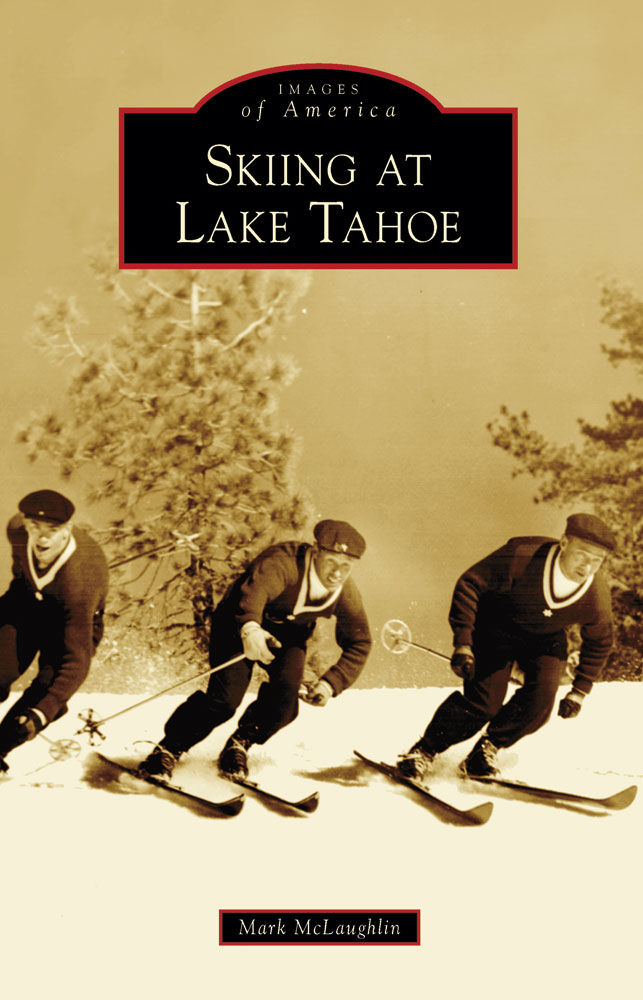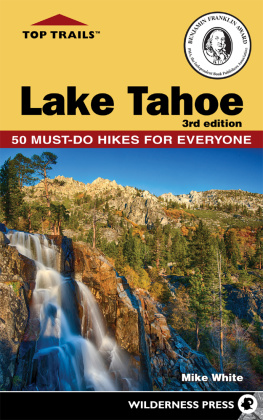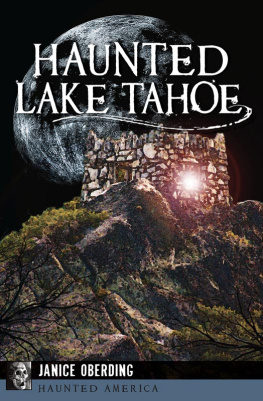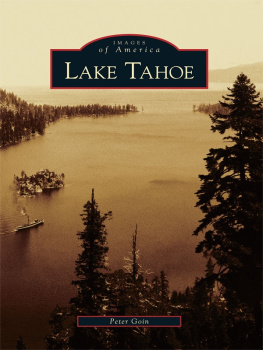
IMAGES
of America
SKIING AT
LAKE TAHOE

The California Chamber of Commerce began promoting skiing in the Golden State after the International Olympic Committee rejected the states bid for the 1932 winter games. This promotional photograph by Jervie H. Eastman captures Dick Brown jumping the road to Mount Lassen in 1940. The two women on the car are Artis Tunnison (left) and Beverly Irish. (Courtesy Truckee Donner Historical Society.)
ON THE COVER: Dodge Ridge ski instructors Gordon Soltau (left), Eric Johnson (center), and Wayne Wisauen race side by side in the 1950s. The Lake Tahoe region was already a favorite skiing destination for Californians and Western Nevadans, but after the highly successful 1960 Winter Olympics at Squaw Valley, the whole world took notice. (Courtesy Donner Summit Historical Society/Norm Sayler collection.)
IMAGES
of America
SKIING AT
LAKE TAHOE
Mark McLaughlin

Copyright 2011 by Mark McLaughlin
ISBN 978-0-7385-8906-0
Ebook ISBN 9781439642559
Published by Arcadia Publishing
Charleston, South Carolina
Library of Congress Control Number: 2011933819
For all general information, please contact Arcadia Publishing:
Telephone 843-853-2070
Fax 843-853-0044
E-mail
For customer service and orders:
Toll-Free 1-888-313-2665
Visit us on the Internet at www.arcadiapublishing.com
In memory of Robert Fro Frohlich (19552010), an award-winning Tahoe ski journalist. A talented writer and hard-charging skier, Frohlich had a bold passion for winter sport and a hearty appetite for the next adventure.
CONTENTS
Very special thanks to Norm Sayler, president of the Donner Summit Historical Society, for sharing his invaluable knowledge regarding regional ski history and for the generous use of images from the societys extensive collection. Much appreciation to the Truckee Donner Historical Society, North Lake Tahoe Historical Society, Western SkiSport Museum, Nevada Historical Society, and South Lake Tahoe Historical Society for the photographs related to the development of Lake Tahoe skiing. This book is better because of the generosity of the following people, who shared background information or historical images from their personal or private collections: Craig Beck, Dana Scanlon, Bill Klein, Vi White, Dick Dorworth, Scott Lawson, Rob Russell, Gary Noy, Tom Ice Man Macaulay, the Keston Ramsey family, Frank Titus, David C. Antonucci, David Borges, Bill Oudegeest, Rick and Sue Lundblade, and Rick Brower.
Special thanks to several professional photographers who contributed quality images of modern skiing and snowboarding in the Tahoe region: David E. Caramazzi (www.egidio.com), Keoki Flagg (www.gallerykeoki.com), and Jeff Engerbretson (Diamond Peak). Bill Briner, the official photographer at the 1960 Squaw Valley Olympics, generously contributed images and personal recollections from those Winter Games (www.1960olympicphotos.com). Please visit their websites for more information. A debt of gratitude is owed to my research assistant Meghan Robins for her help in tracking down images and information for this project.
As always, my parents, John and Florence, deserve mention for their ongoing encouragement to pursue my dreams. And finally, thank you to my wife, Nora ONeill, for her absolute support and understanding as I spent several months focused on this book to meet the publication deadline.
Ski racing in the northern Sierra Nevada harkens back to the 1850s, when grizzled miners rode rusty ore buckets up the mountain and then skied down on short wooden barrel staves mounted with crude leather bindings. Within a decade, racing had morphed into a popular sport in which speed-crazed locals barreled down the mountain on skis up to 15 feet long at speeds approaching 100 miles per hour. These people were the fastest humans on the planet, and the speed records set on those long, heavy boards were not broken until nearly 80 years later.
For these miners, considered the first ski racers in North America, it took a lot of whiskey and serious betting to get them to push the boundaries of physics and good sense. But the boards got longerand the racers went fasteruntil the thrill of speed overcame the fear of death.
California skiing got its start not as a sport per se but as a form of transportation over deep snow. Norwegians who arrived during the Gold Rush introduced the concept of skiing on planks of wood as opposed to using web-style snowshoes. It was not long before the adaptive miners were traveling smoothly over the snowbound Sierra, pushing themselves along with one long pole. Doctors were soon skiing for miles to treat injuries or deliver babies. Residents in snow country skied to work and hauled supplies on skiseven at funerals, mourners and pallbearers glided smoothly along.
It was not long before communities throughout the Lost Sierra region of Plumas and Sierra Counties had skiers competing for bragging rights. Mining towns sponsored long-board ski teams that raced for cash prizes worth hundreds of dollars. Americas first organized ski club was formed when Creed Raymond founded the Alturas Snowshoe Club at La Porte in 1867. (The worlds first ski clubs were started in Norway and Australia in 1861.)
The Alturas Snowshoe Club was founded for the physical and mental well-being of the miners, although alcohol-fueled high-speed crashes took their toll. The first downhill racecourse in the western hemisphere was laid out at Johnsville in Plumas County. The course was 1,230 feet long and ran straight down the mountain. There were no chairlifts or rope tows, so the winner of each heat had to hike back up the mountain in order to race again. The boards were long, heavy, and had no side cut to aid in turning. It was all about speed.
By the late 1880s, the mines of the Lost Sierra were tapped out and the longboard-racing era was winding down. Following the construction of the first transcontinental railroad, the town of Truckee, in Nevada County, became the gateway to the central Sierras winter wonderland. Local businessman Charles F. McGlashan was an intelligent and energetic jack-of-all-trades. In the early 1890s, McGlashan shared his prescient vision of the railroad town of Truckee as a major attraction for winter sports. His persuasive proposal energized Truckees business community, and they wholeheartedly decided to capitalize on the idea. The cities of Quebec, Canada, and St. Paul, Minnesota, had boosted their local economies with winter carnivalsTruckee could, too.
McGlashan had argued that well-advertised and -promoted ice carnivals and midwinter festivals would spur thousands of people to take the train from the dreary flatlands to Truckee. Before long, Southern Pacific Snowball Express party trains were conveying hundreds of tourists to Truckee so they could enjoy the annual winter carnival the town first established in 1895. Every weekend from early February into March, fun-loving visitors could spend the day sledding, ice skating, and tobogganing before Saturday night dancing and saloon-hopping in Truckees business district. Hilltop, the small hill with an open slope located across the river from downtown Truckee, provided an excellent place to sled and toboggan. In 1910, an old steam engine from an abandoned lumber mill was hauled in by ox-drawn wagons and converted into a pullback lift. Some ski historians believe this was the first mechanical lift of its kind in the United States.
Next page







